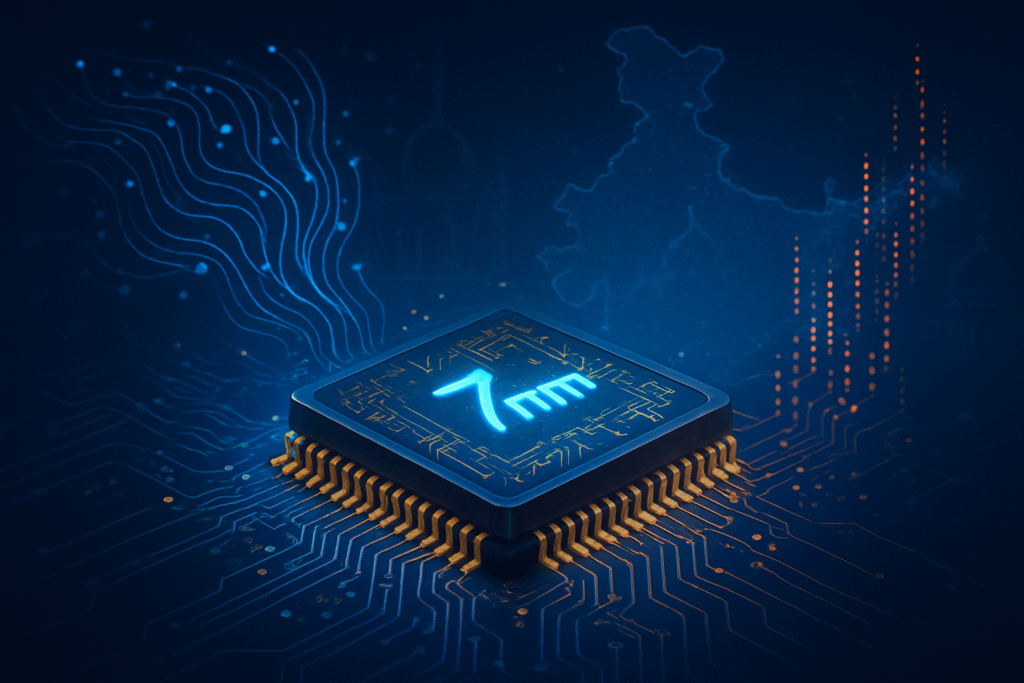
In a landmark announcement on October 18, 2025, Union Minister Ashwini Vaishnaw unveiled India's ambitious roadmap for the development of its indigenous 7-nanometer (nm) processor. This pivotal initiative marks a significant stride in the nation's quest for semiconductor self-reliance and positions India as an emerging force in the global chip design and manufacturing landscape. The move is set to profoundly impact the artificial intelligence (AI) sector, promising to accelerate indigenous AI/ML platforms and reduce reliance on imported advanced silicon for critical applications.
The cornerstone of this endeavor is the 'Shakti' processor, a project spearheaded by the Indian Institute of Technology Madras (IIT Madras). While the official announcement confirmed the roadmap and ongoing progress, the first indigenously designed 7nm 'Shakti' computer processor is anticipated to be ready by 2028. This strategic development is poised to bolster India's digital sovereignty, enhance its technological capabilities in high-performance computing, and provide a crucial foundation for the next generation of AI innovation within the country.
Technical Prowess: Unpacking India's 7nm 'Shakti' Processor
The 'Shakti' processor, currently under development at IIT Madras's SHAKTI initiative, represents a significant technical leap for India. It is being designed based on the open-source RISC-V instruction set architecture (ISA). This choice is strategic, offering unparalleled flexibility, customization capabilities, and freedom from proprietary licensing fees, which can be substantial for established ISAs like x86 or ARM. The open-source nature of RISC-V fosters a collaborative ecosystem, enabling broader participation from research institutions and startups, and accelerating innovation.
The primary technical specifications target high performance and energy efficiency, crucial attributes for modern computing. While specific clock speeds and core counts are still under wraps, the 7nm process node itself signifies a substantial advancement. This node allows for a much higher transistor density compared to older, larger nodes (e.g., 28nm or 14nm), leading to greater computational power within a smaller physical footprint and reduced power consumption. This directly translates to more efficient processing for complex AI models, faster data handling in servers, and extended battery life in potential future edge devices.
This indigenous 7nm development markedly differs from previous Indian efforts that largely focused on design using imported intellectual property or manufacturing on older process nodes. By embracing RISC-V and aiming for a leading-edge 7nm node, India is moving towards true architectural and manufacturing independence. Initial reactions from the domestic AI research community have been overwhelmingly positive, with experts highlighting the potential for optimized hardware-software co-design specifically tailored for Indian AI workloads and data sets. International industry experts, while cautious about the timelines, acknowledge the strategic importance of such an initiative for a nation of India's scale and technological ambition.
The 'Shakti' processor is specifically designed for server applications across critical sectors such as financial services, telecommunications, defense, and other strategic domains. Its high-performance capabilities also make it suitable for high-performance computing (HPC) systems and, crucially, for powering indigenous AI/ML platforms. This targeted application focus ensures that the processor will address immediate national strategic needs while simultaneously laying the groundwork for broader commercial adoption.
Reshaping the AI Landscape: Implications for Companies and Market Dynamics
India's indigenous 7nm processor development carries profound implications for AI companies, global tech giants, and burgeoning startups. Domestically, companies like Tata Group (NSE: TATACHEM) (which is already investing in a wafer fabrication facility) and other Indian AI solution providers stand to benefit immensely. The availability of locally designed and eventually manufactured advanced processors could reduce hardware costs, improve supply chain predictability, and enable greater customization for AI applications tailored to the Indian market. This fosters an environment ripe for innovation among Indian AI startups, allowing them to build solutions on foundational hardware designed for their specific needs, potentially leading to breakthroughs in areas like natural language processing for Indian languages, computer vision for diverse local environments, and AI-driven services for vast rural populations.
For major global AI labs and tech companies such as Google (NASDAQ: GOOGL), Microsoft (NASDAQ: MSFT), and Amazon (NASDAQ: AMZN) (AWS), this development presents both opportunities and competitive shifts. While these giants currently rely on global semiconductor leaders like TSMC (NYSE: TSM) and Samsung (KRX: 005930) for their advanced AI accelerators, an independent Indian supply chain could eventually offer an alternative or complementary source, especially for services targeting the Indian government and strategic sectors. However, it also signifies India's growing ambition to compete in advanced silicon, potentially disrupting the long-term dominance of established players in certain market segments, particularly within India.
The potential disruption extends to existing products and services that currently depend entirely on imported chips. An indigenous 7nm processor could lead to the development of 'Made in India' AI servers, supercomputers, and edge AI devices, potentially creating a new market segment with unique security and customization features. This could shift market positioning, giving Indian companies a strategic advantage in government contracts and sensitive data processing where national security and data sovereignty are paramount. Furthermore, as India aims to become a global player in advanced chip design, it could eventually influence global supply chains and foster new international collaborations, as evidenced by ongoing discussions with entities like IBM (NYSE: IBM) and Belgium-based IMEC.
The long-term vision is to attract significant investments and create a robust semiconductor ecosystem within India, which will inevitably fuel the growth of the AI sector. By reducing reliance on external sources for critical hardware, India aims to mitigate geopolitical risks and ensure the uninterrupted advancement of its AI initiatives, from academic research to large-scale industrial deployment. This strategic move could fundamentally alter the competitive landscape, fostering a more diversified and resilient global AI hardware ecosystem.
Wider Significance: India's Role in the Global AI Tapestry
India's foray into indigenous 7nm processor development fits squarely into the broader global AI landscape, which is increasingly characterized by a race for hardware superiority and national technological sovereignty. With AI models growing exponentially in complexity and demand for computational power, advanced semiconductors are the bedrock of future AI breakthroughs. This initiative positions India not merely as a consumer of AI technology but as a significant contributor to its foundational infrastructure, aligning with global trends where nations are investing heavily in domestic chip capabilities to secure their digital futures.
The impacts of this development are multi-faceted. Economically, it promises to create a high-skill manufacturing and design ecosystem, generating employment and attracting foreign investment. Strategically, it significantly reduces India's dependence on imported chips for critical applications, thereby strengthening its digital sovereignty and supply chain resilience. This is particularly crucial in an era of heightened geopolitical tensions and supply chain vulnerabilities. The ability to design and eventually manufacture advanced chips domestically provides a strategic advantage in defense, telecommunications, and other sensitive sectors, ensuring that India's technological backbone is secure and self-sufficient.
Potential concerns, however, include the immense capital expenditure required for advanced semiconductor fabrication, the challenges of scaling production, and the intense global competition for talent and resources. Building a complete end-to-end semiconductor ecosystem from design to fabrication and packaging is a monumental task that typically takes decades and billions of dollars. While India has a strong talent pool in chip design, establishing advanced manufacturing capabilities remains a significant hurdle.
Comparing this to previous AI milestones, India's 7nm processor ambition is akin to other nations' early investments in supercomputing or specialized AI accelerators. It represents a foundational step that, if successful, could unlock a new era of AI innovation within the country, much like the development of powerful GPUs revolutionized deep learning globally. This move also resonates with the global push for diversification in semiconductor manufacturing, moving away from a highly concentrated supply chain to a more distributed and resilient one. It signifies India's commitment to not just participate in the AI revolution but to lead in critical aspects of its underlying technology.
Future Horizons: What Lies Ahead for India's Semiconductor Ambitions
The announcement of India's indigenous 7nm processor roadmap sets the stage for a dynamic period of technological advancement. In the near term, the focus will undoubtedly be on the successful design and prototyping of the 'Shakti' processor, with its expected readiness by 2028. This phase will involve rigorous testing, optimization, and collaboration with potential fabrication partners. Concurrently, efforts will intensify to build out the necessary infrastructure and talent pool for advanced semiconductor manufacturing, including the operationalization of new wafer fabrication facilities like the one being established by the Tata Group in partnership with Powerchip Semiconductor Manufacturing Corp. (PSMC).
Looking further ahead, the long-term developments are poised to be transformative. The successful deployment of 7nm processors will likely pave the way for even more advanced nodes (e.g., 5nm and beyond), pushing the boundaries of India's semiconductor capabilities. Potential applications and use cases on the horizon are vast and impactful. Beyond server applications and high-performance computing, these indigenous chips could power advanced AI inference at the edge for smart cities, autonomous vehicles, and IoT devices. They could also be integrated into next-generation telecommunications infrastructure (5G and 6G), defense systems, and specialized AI accelerators for cutting-edge research.
However, significant challenges need to be addressed. Securing access to advanced fabrication technology, which often involves highly specialized equipment and intellectual property, remains a critical hurdle. Attracting and retaining top-tier talent in a globally competitive market is another ongoing challenge. Furthermore, the sheer financial investment required for each successive node reduction is astronomical, necessitating sustained government support and private sector commitment. Ensuring a robust design verification and testing ecosystem will also be paramount to guarantee the reliability and performance of these advanced chips.
Experts predict that India's strategic push will gradually reduce its import dependency for critical chips, fostering greater technological self-reliance. The development of a strong domestic semiconductor ecosystem is expected to attract more global players to set up design and R&D centers in India, further bolstering its position. The ultimate goal, as outlined by the India Semiconductor Mission (ISM), is to position India among the top five chipmakers globally by 2032. This ambitious target, while challenging, reflects a clear national resolve to become a powerhouse in advanced semiconductor technology, with profound implications for its AI future.
A New Era of Indian AI: Concluding Thoughts
India's indigenous 7-nanometer processor development represents a monumental stride in its technological journey and a definitive declaration of its intent to become a self-reliant powerhouse in the global AI and semiconductor arenas. The announcement of the 'Shakti' processor roadmap, with its open-source RISC-V architecture and ambitious performance targets, marks a critical juncture, promising to reshape the nation's digital future. The key takeaway is clear: India is moving beyond merely consuming technology to actively creating foundational hardware that will drive its next wave of AI innovation.
The significance of this development in AI history cannot be overstated. It is not just about building a chip; it is about establishing the bedrock for an entire ecosystem of advanced computing, from high-performance servers to intelligent edge devices, all powered by indigenous silicon. This strategic independence will empower Indian researchers and companies to develop AI solutions with enhanced security, customization, and efficiency, tailored to the unique needs and opportunities within the country. It signals a maturation of India's technological capabilities and a commitment to securing its digital sovereignty in an increasingly interconnected and competitive world.
Looking ahead, the long-term impact will be measured by the successful execution of this ambitious roadmap, the ability to scale manufacturing, and the subsequent proliferation of 'Shakti'-powered AI solutions across various sectors. The coming weeks and months will be crucial for observing the progress in design finalization, securing fabrication partnerships, and the initial reactions from both domestic and international industry players as more technical details emerge. India's journey towards becoming a global semiconductor and AI leader has truly begun, and the world will be watching closely as this vision unfolds.
This content is intended for informational purposes only and represents analysis of current AI developments.
TokenRing AI delivers enterprise-grade solutions for multi-agent AI workflow orchestration, AI-powered development tools, and seamless remote collaboration platforms.
For more information, visit https://www.tokenring.ai/.





